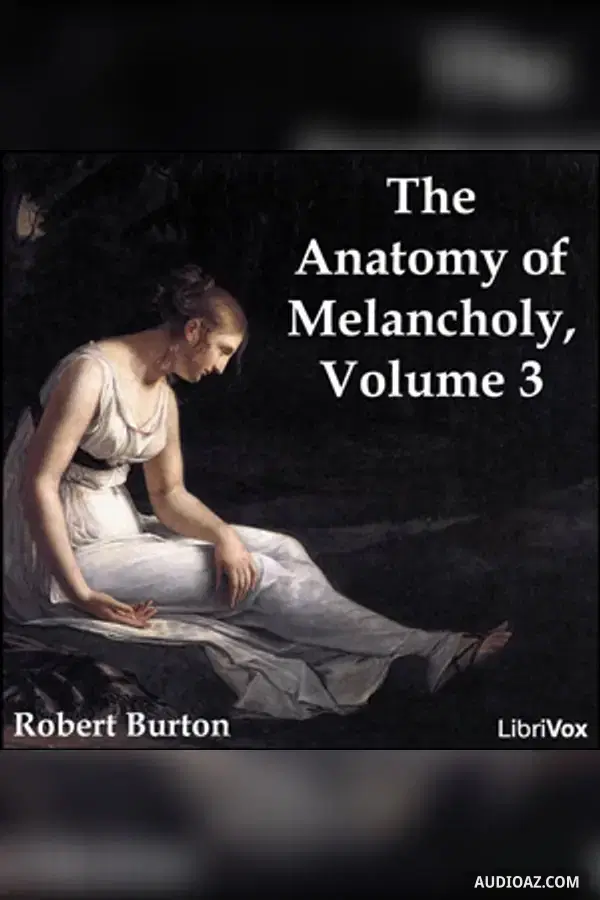
The Anatomy of Melancholy Volume 3 - Audiolibro Gratis
Autor(es): Robert Burton,
1 / 4901 - Partition 3, Section 1, Member 1, Subsection 1
- 1. 01 - Partition 3, Section 1, Member 1, Subsection 1
- 2. 02 - Partition 3, Section 1, Member 1, Subsection 2
- 3. 03 - Partition 3, Section 1, Member 2, Subsection 1
- 4. 04 - Partition 3, Section 1, Member 2, Subsections 2 and 3
- 5. 05 - Partition 3, Section 1, Member 3
- 6. 06 - Partition 3, Section 2, Member 1, Subsection 1
- 7. 07 - Partition 3, Section 2, Member 1, Subsection 2
- 8. 08 - Partition 3, Section 2, Member 2, Subsection 1
- 9. 09 - Partition 3, Section 2, Member 2, Subsection 2, Part 1
- 10. 10 - Partition 3, Section 2, Member 2, Subsection 2, Part 2
- 11. 11 - Partition 3, Section 2, Member 2, Subsection 2, Part 3
- 12. 12 - Partition 3, Section 2, Member 2, Subsection 3
- 13. 13 - Partition 3, Section 2, Member 2, Subsection 4, Part 1
- 14. 14 - Partition 3, Section 2, Member 2, Subsection 4, Part 2
- 15. 15 - Partition 3, Section 2, Member 2, Subsection 5
- 16. 16 - Partition 3, Section 2, Member 3, Part 1
- 17. 17 - Partition 3, Section 2, Member 3, Part 2
- 18. 18 - Partition 3, Section 2, Member 3, Part 3
- 19. 19 - Partition 3, Section 2, Member 3, Part 4
- 20. 20 - Partition 3, Section 2, Member 4
- 21. 21 - Partition 3, Section 2, Member 5, Subsection 1
- 22. 22 - Partition 3, Section 2, Member 5, Subsection 2
- 23. 23 - Partition 3, Section 2, Member 5, Subsection 3, Part 1
- 24. 24 - Partition 3, Section 2, Member 5, Subsection 3, Part 2
- 25. 25 - Partition 3, Section 2, Member 5, Subsection 4
- 26. 26 - Partition 3, Section 2, Member 5, Subsection 5, Part 1
- 27. 27- Partition 3, Section 2, Member 5, Subsection 5, Part 2
- 28. 28 - Partition 3, Section 3, Member 1, Subsection 1
- 29. 29 - Partition 3, Section 3, Member 1, Subsection 2, Part 1
- 30. 30 - Partition 3, Section 3, Member 1, Subsection 2, Part 2
- 31. 31 - Partition 3, Section 3, Member 2
- 32. 32 - Partition 3, Section 3, Member 3
- 33. 33 - Partition 3, Section 3, Member 4, Subsection 1
- 34. 34 - Partition 3, Section 3, Member 4, Subsection 2
- 35. 35 - Partition 3, Section 4, Member 1, Subsection 1
- 36. 36 - Partition 3, Section 4, Member 1, Subsection 2, Part 1
- 37. 37 - Partition 3, Section 4, Member 1, Subsection 2, Part 2
- 38. 38 - Partition 3, Section 4, Member 1, Subsection 3, Part 1
- 39. 39 - Partition 3, Section 4, Member 1, Subsection 3, Part 2
- 40. 40 - Partition 3, Section 4, Member 1, Subsection 3, Part 3
- 41. 41 - Partition 3, Section 4, Member 1, Subsection 4
- 42. 42 - Partition 3, Section 4, Member 1, Subsection 5
- 43. 43 - Partition 3, Section 4, Member 2, Subsection 1
- 44. 44 - Partition 3, Section 4, Member 2, Subsection 2
- 45. 45 - Partition 3, Section 4, Member 2, Subsection 3
- 46. 46 - Partition 3, Section 4, Member 2, Subsections 4 and 5
- 47. 47 - Partition 3, Section 4, Member 2, Subsection 6, Part 1
- 48. 48 - Partition 3, Section 4, Member 2, Subsection 6, Part 2
- 49. 49 - Partition 3, Section 4, Member 2, Subsection 6, Part 3
Acerca de
The Anatomy of Melancholy is a book by Robert Burton, first published in 1621. On its surface, the book is a medical textbook in which Burton applies his large and varied learning in the scholastic manner to the subject of melancholia (which includes what is now termed clinical depression).
Though presented as a medical text, The Anatomy of Melancholy is as much a sui generis work of literature as it is a scientific or philosophical text, and Burton addresses far more than his stated subject. In fact, the Anatomy uses melancholy as the lens through which all human emotion and thought may be scrutinized, and virtually the entire contents of a 17th-century library are marshalled into service of this goal.
Burton is forthright about his intentions in writing the Anatomy — "I write of melancholy by being busy to avoid melancholy," he concedes. This acknowledged desire to distract and amuse himself motivated Burton to produce a wide-ranging document, containing digressions and commentary. Whatever its strengths as a medical text or as a historical document, it is the Anatomy's vast breadth — addressing topics such as digestion, goblins, the geography of America, and others — and the particularly characteristic voice of its author that are most commonly cited by its admirers as the main sources of its appeal. Both satirical and serious in tone, the Anatomy is "vitalized by (Burton's) pervading humour", and Burton's digressive and inclusive style, often verging on a stream of consciousness, consistently informs and animates the text. (Summary from Wikipedia)
Comentarios
Audiolibros Relacionados
Etiquetas: The Anatomy of Melancholy Volume 3 audio, The Anatomy of Melancholy Volume 3 - Robert Burton audio, Salud y bienestar audio, No ficción audio, Psicología audio, free audiobook, free audio book, audioaz






